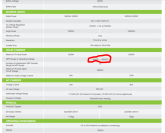AgroVenturesPeru
New Member
- Joined
- Sep 19, 2020
- Messages
- 411
I'd like to know what the best panel array would be in my situation (let's disregard the economic aspects of the decision). I'm concerned in knowing which option is the most efficient. I think I know the answer, but want to know what people with more experience would select. Also, feel free to suggest your own alternative idea, if you feel there is a better option.
This location is 6 degrees from the equator and 3,000feet elevation, but cloudy days are common.
This place will probably never see a temperature below 40 degrees Fahrenheit.

Needs: To charge a 48v, 9.6kwh battery bank (these are the useable kwh). Total kwh of battery = 10.5kwh
Here is a picture of the MPPT/Inverter confines I need to work within:

A)
12; 315W Monocrystalline Panels (3,780W total)
Arrangement: 3s4p (s=series; p=parallel); Totals: 101.25V / 37.36A
41.18Voc
33.75Vmp
9.99A (Isc)
9.34A (Imp)
B)
8; 450W Monocrystalline Panels (3,600W total)
Arrangement: 2s4p; Totals: 81.3V / 44.28A
49.57Voc
40.65Vmp
11.49A (Isc)
11.07A (Imp)
C)
9; 400W Monocrystalline Panels (3,600W total)
Arrangement: 3s3p; Totals: 121.8V / 29.58A
48.64Voc
40.6Vmp
10.3A (Isc)
9.86 (Imp)
D)
12; 320W Polycrystalline Panels (3,840W total)
Arrangement: 3s4p; Totals: 94.68V / 32.28A
36.62Voc
31.56Vmp
8.88A (Isc)
8.07A (Imp)
Bonus question: How could the charge controller have an allowance for the maximum PV array power of 4500W when the maximum solar charge current is only 80A?
This location is 6 degrees from the equator and 3,000feet elevation, but cloudy days are common.
This place will probably never see a temperature below 40 degrees Fahrenheit.

Needs: To charge a 48v, 9.6kwh battery bank (these are the useable kwh). Total kwh of battery = 10.5kwh
Here is a picture of the MPPT/Inverter confines I need to work within:

A)
12; 315W Monocrystalline Panels (3,780W total)
Arrangement: 3s4p (s=series; p=parallel); Totals: 101.25V / 37.36A
41.18Voc
33.75Vmp
9.99A (Isc)
9.34A (Imp)
B)
8; 450W Monocrystalline Panels (3,600W total)
Arrangement: 2s4p; Totals: 81.3V / 44.28A
49.57Voc
40.65Vmp
11.49A (Isc)
11.07A (Imp)
C)
9; 400W Monocrystalline Panels (3,600W total)
Arrangement: 3s3p; Totals: 121.8V / 29.58A
48.64Voc
40.6Vmp
10.3A (Isc)
9.86 (Imp)
D)
12; 320W Polycrystalline Panels (3,840W total)
Arrangement: 3s4p; Totals: 94.68V / 32.28A
36.62Voc
31.56Vmp
8.88A (Isc)
8.07A (Imp)
Bonus question: How could the charge controller have an allowance for the maximum PV array power of 4500W when the maximum solar charge current is only 80A?





